Commuting
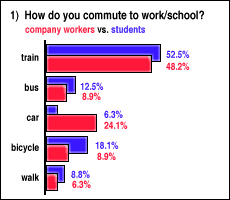 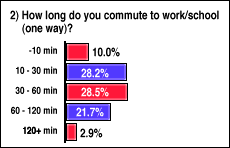 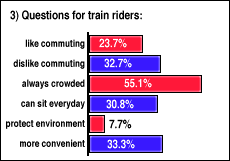 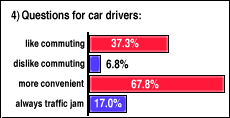 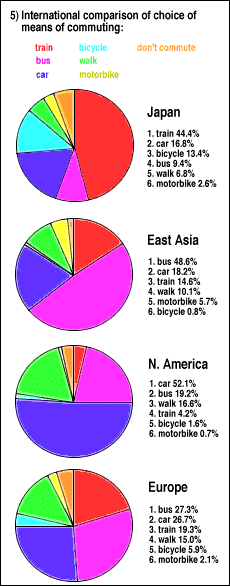 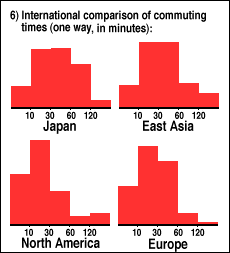 |
In addition, we sent the survey to about 3600 people who were registered in the categories of East Asian, North American and European countries (see details at the bottom of the page). We received 347 valid responses from East Asia, 307 from North America and 187 from Europe.
Please note that the compositions of the groups of people which we are going to call "Japanese", "East Asians", "North Americans" and "Europeans" in the following article, do not proportionally correspond to the actual demographics of those world regions in many respects. Also, please note that a large majority of survey participants are between 18 and 30 years old and have access to the internet. For these and other reasons, the survey is far from representative; yet it will give us a broad picture.
In this survey, we tried to find out how long and with what means of transportation Japanese students and company workers commute to school and work. In addition, we wanted to compare the commuting behaviour in Japan with the ones in other parts of the world.
How do the Japanese commute?
According to our survey results, the train is by far the most commonly used means of transportation for commuting in Japan. A majority of 53% of students and 48% of company workers indicated to commute to school/work by train or subway. Another 13% of students and 9% of company workers use the bus or street car, which results in a "market share" for public transportation of 61% among students and 57% among company workers.
The car, on the other hand, is chosen by 24% of company workers and 6% of students for their daily commuting. The car is a much more common means of commuting in the countryside where it is the choice of 64% of the company workers, compared to 14% of company workers from the city.
While the car is the second most popular means of transportation among company workers, the bicycle takes that position among students, with 18% using it to commute to school. Also a high 9% of company workers ride to work by bike. Among the remaining survey participants, 7% indicated to walk to school/work, and 3% take the motorcycle, while 7% indicated not to commute at all.
International comparison: Public transportation
In international comparison, the Japanese are heavy users of trains and public transportation in general. While about every second Japanese company worker commutes by trains, train riders make up only 24% among other East Asian, 13% among European, and a very low 3% of North American company workers. Busses, on the other hand, which are the main means of commuting of only 9% of Japanese company workers, are the choice of 39% of other East Asian, 13% of North American and 11% of European company workers.
The market share of public transportation is highest in East Asian countries other than Japan with 64% among company workers and 73% among students using bus and train. In Western countries, less people use public transportation, and the difference between students and company workers with regard to usage of trains and busses is larger: while 27% of North American students use bus or train, only 16% of company workers do; and the contrast is even greater in Europe where a large majority of 64% of students use public transportation, but only 23% of company workers do.
International comparison: Car and Bicycle
The car is by far the most common means of commuting in North America where 71% of company workers and every second student commute by car. The situation is less extreme in Europe where 58% of company workers, but only 10% of students commute by car. In East Asia, car drivers make up 25% among company workers and 15% among students.
The bicycle enjoys by far the greatest popularity among Japanese commuters according to our survey results. As mentioned before, almost one out of five Japanese students and one out of ten company workers take the bike to school/work. Among Europeans, the bicycle is with a market share of 8% also quite popular among students, but with 2% barely chosen by company workers. The situation looks even worse in North America and East Asia where less than 2% of students and company workers commute by bicycle.
How long do the Japanese commute?
In our second question, we asked the survey participants, how long it takes for them to commute to work in one direction. About half of the Japanese respondents indicated that they need less than 30 minutes to go to work/school. On the other hand, one fourth of the respondents need more than one hour. In addition, the results show that it takes students longer to commute than company workers: 34% of students commute for over one hour while only 21% of company workers travel that long.
Train riders are underway the longest with half of them traveling for more than one hour. 60% of car drivers, on the other hand, need less than 30 minutes to commute to work/school. Also commuters taking the bus do not travel as long as train riders: for 70% of them it takes less than an hour to commute one way. Almost 7% of people from the countryside indicated to commute for over two hours per direction and day. The same group makes up only 2% among people from cities.
International comparison
The Japanese spend more time commuting than either other East Asians, Europeans and especially North Americans. Americans and Canadians seem to live closest to their working place or school: One out of four North Americans commutes as little as ten minutes or less in one way, and for two thirds it takes less than 30 minutes. Only 24% of North American commuters are underway for more than 30 minutes and only 8% for more than one hour. Also a majority of Europeans lives within 30 minutes of their working space or school. The number of commuters traveling between 30 and 60 minutes, however, is with 33% higher than in North America. On the other hand, very few Europeans (6%) are commuting for more than one hour. Also, the percentage of people walking to work or school is much lower in Japan (7%) than in either East Asia (18%), North America (17%) and Europe (15%).
About the happiness of commuters
In our next question, we asked the survey participants whether they like or dislike the way in which they are currently commuting. 36% of the Japanese respondents are content with their current way of commuting, while 23% dislike it. Most content with their situation are the people who walk or cycle to work/school with 68% and 64% indicating to like commuting in the current way. Only among train riders, unhappy commuters (33%) outnumber the happy ones (24%).
In international comparison, the Japanese are not very happy commuters. The percentage of happy commuters is higher in all the other regions: East Asia (48%), Europe (52%) and North America (61%).
Questions for users of public transportation
In the next question we asked the users of public transportation how crowded the trains and busses are, and whether they are usually able to find a seat. A majority of 55% of Japanese train riders indicated that the train is always very crowded. On the other hand, 31% indicated to find a seat most of the time. The situation is better among bus riders among who only 39% responded that the bus is always very crowded, and 49% are able to sit most of the time.
Only 31% of North American responding bus riders were complaining about crowded busses. The same opinion had 34% of bus riders and 25% of train riders in Europe and 31% of East Asian bus riders.
On our question whether they are using public transportation in order to protect the environment, 6% of Japanese bus riders and 8% of train riders responded affirmatively. About one third of the Japanese respondents choose public transportation because they find it more convenient than the car.
Among East Asians, the percentage of bus riders who use busses because of environmental concerns is with 13% higher than in Japan. It is even higher among North American bus riders (25%), European bus riders (28%) and European train riders (36%). The percentage of commuters who prefer public transportation over the car because it is more convenient, is with one third of respondents about the same in Europe as in Japan, but much lower in North America and East Asia where only one out of five commuters chooses public transportation for that reason.
Notes:
For the results from East Asia, we sent the survey to about 1400 people who were registered in the categories of South Korea (443), Thailand (327), Hong Kong (176), Singapore (171), Indonesia (111), Malaysia (109) and China (84). For the results from North America we sent the survey to 1000 Americans and 180 Canadians; and for the European results we sent about 1000 surveys to people registered in the categories of Germany (379), Italy (166), UK (148), France (101), Sweden (43), Spain (38), Austria (29) and Switzerland (27).
Questions? Ask in our forum.

